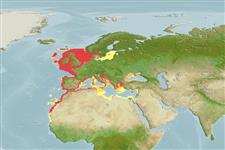Elasmobranquios (tiburones y rayas) (sharks and rays) >
Carcharhiniformes (Ground sharks) >
Triakidae (Houndsharks) > Triakinae
Etymology: Mustelus: Latin for weasel, an ancient name for sharks, possibly referring to the pointed snouts, swift movements and/or rapacious feeding behavior of smaller predatory sharks [strictly not tautonymous with Squalus mustelus Linnaeus 1758 since type was designated by the ICZN]. (See ETYFish); asterias: Starry, referring to many small white spots on dorsal (upper) surface of body. (See ETYFish).
Environment: milieu / climate zone / depth range / distribution range
Ecología
marino demersal; rango de profundidad 0 - 350 m (Ref. 6808). Temperate; 61°N - 16°N, 19°W - 36°E
Northeast Atlantic: British Isles and North Sea to Canary Islands, including the Mediterranean and Mauritania.
Length at first maturity / Tamaño / Peso / Age
Maturity: Lm 81.0, range 85 - ? cm
Max length : 154 cm TL macho / no sexado; (Ref. 86318); peso máximo publicado: 4.8 kg (Ref. 4699)
A common inshore and offshore shark found on the continental and insular shelves from the intertidal down to at least 100 m. Prefers sandy and gravelly bottom. Feeds primarily on crustaceans (crabs, hermit crabs, lobsters and slipper lobsters). Ovoviviparous (aplacental), with 7 to 15 young per litter. Size at birth about 30 cm. Utilized fresh and dried salted.
Ovoviviparous, embryos feed solely on yolk (Ref. 50449).
Compagno, L.J.V., 1984. FAO Species Catalogue. Vol. 4. Sharks of the world. An annotated and illustrated catalogue of shark species known to date. Part 2 - Carcharhiniformes. FAO Fish. Synop. 125(4/2):251-655. Rome: FAO. (Ref. 244)
IUCN Red List Status (Ref. 130435)
Threat to humans
Harmless
Human uses
Pesquerías: comercial; pesca deportiva: si
Más información
ReferenciasAcuiculturaPerfil de acuiculturaRazasGenéticaElectrophoresesheritabilidadEnfermedadesProcesamientoNutrientsMass conversion
Herramientas
Special reports
Download XML
Fuentes de Internet
Estimates based on models
Preferred temperature (Ref.
123201): 7 - 16.2, mean 10.1 °C (based on 587 cells).
Phylogenetic diversity index (Ref.
82804): PD
50 = 0.5000 [Uniqueness, from 0.5 = low to 2.0 = high].
Bayesian length-weight: a=0.00170 (0.00143 - 0.00202), b=3.13 (3.08 - 3.18), in cm total length, based on LWR estimates for this species (Ref.
93245).
Nivel trófico (Ref.
69278): 3.6 ±0.3 se; based on diet studies.
Generation time: 7.5 ( na - na) years. Estimated as median ln(3)/K based on 2
growth studies.
Resiliencia (Ref.
120179): Muy bajo, población duplicada en un tiempo mínimo superior a 14 años (tm=2-3; Fec=7).
Fishing Vulnerability (Ref.
59153): High to very high vulnerability (71 of 100).
Climate Vulnerability (Ref.
125649): Moderate to high vulnerability (49 of 100).
Nutrients (Ref.
124155): Calcium = 7.5 [2.7, 39.2] mg/100g; Iron = 0.16 [0.05, 0.62] mg/100g; Protein = 21.2 [18.8, 23.6] %; Omega3 = 0.236 [0.101, 0.548] g/100g; Selenium = 22.7 [7.0, 76.8] μg/100g; VitaminA = 6.69 [2.12, 20.78] μg/100g; Zinc = 0.428 [0.190, 0.861] mg/100g (wet weight);
